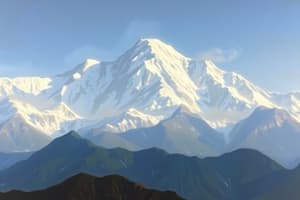Podcast
Questions and Answers
What is the highest peak in the Himalayan Mountains?
What is the highest peak in the Himalayan Mountains?
- Kanchenjunga
- Nanda Devi
- Annapurna
- Mount Everest (correct)
What is the process that formed the Himalayan Mountains?
What is the process that formed the Himalayan Mountains?
- Volcanic activity
- Collision between tectonic plates (correct)
- Weathering and erosion
- Deposition of sediments
What type of soil is characteristic of the Deccan Plateau?
What type of soil is characteristic of the Deccan Plateau?
- Clay soil
- Sandy soil
- Red soil
- Black soil (regur soil) (correct)
What is the name of the desert located in northwestern India?
What is the name of the desert located in northwestern India?
What is the main characteristic of the Coastal Plains?
What is the main characteristic of the Coastal Plains?
What is the name of the highest range in the Himalayan Mountains?
What is the name of the highest range in the Himalayan Mountains?
What is the climate of the Indian Desert?
What is the climate of the Indian Desert?
What is the main feature of the Deccan Plateau's landscape?
What is the main feature of the Deccan Plateau's landscape?
What is the importance of the Himalayan Mountains in India's climate?
What is the importance of the Himalayan Mountains in India's climate?
What is the main ecosystem found in the Coastal Plains?
What is the main ecosystem found in the Coastal Plains?
Flashcards are hidden until you start studying
Study Notes
Himalayan Mountains
- Stretch for over 2,500 km across northern India
- Formed as a result of the collision between the Indian and Eurasian tectonic plates
- Highest peak: Mount Everest (Nepal), but India's highest peak is Kanchenjunga (8,598m)
- Divided into three parallel ranges:
- Greater Himalayas: highest and most rugged range
- Middle Himalayas: lower in elevation, with fertile valleys and human settlements
- Shiwalik Hills: outermost range, with dense forests and a subtropical climate
- Play a crucial role in India's climate, weather patterns, and water resources
Deccan Plateau
- Covers almost 60% of India's land area
- Formed from volcanic activity and erosion over millions of years
- Characterized by:
- Flat-topped hills and plateaus
- Rivers flowing through it, including the Godavari, Krishna, and Kaveri
- Black soil (regur soil) suitable for agriculture
- Divided into two regions:
- Northern Deccan Plateau: more rugged and elevated
- Southern Deccan Plateau: more gentle slopes and lower elevations
- Supports a wide range of flora and fauna, including forests, grasslands, and wildlife sanctuaries
Coastal Plains
- Narrow strips of land along the Indian Ocean coastline
- Formed by the deposition of sediments by rivers and sea erosion
- Divided into two regions:
- Western Coastal Plain: narrower and more rugged, with a higher elevation
- Eastern Coastal Plain: wider and more fertile, with a lower elevation
- Supports a variety of ecosystems, including mangrove forests, coral reefs, and estuaries
- Home to major ports and industrial centers, including Mumbai and Chennai
Indian Desert
- Also known as the Thar Desert
- Located in the northwestern part of India, covering parts of Rajasthan, Gujarat, and Punjab
- Characterized by:
- Arid climate with low rainfall
- Sandy dunes and scrub vegetation
- Limited vegetation and wildlife
- Supports a unique ecosystem adapted to the harsh desert conditions
- Plays an important role in India's climate and weather patterns, including the formation of the monsoon winds
Himalayan Mountains
- Stretch for over 2,500 km across northern India
- Formed by the collision between the Indian and Eurasian tectonic plates
- Home to the highest peak, Mount Everest (Nepal), and India's highest peak, Kanchenjunga (8,598m)
- Composed of three parallel ranges:
- Greater Himalayas: highest and most rugged range
- Middle Himalayas: lower in elevation, with fertile valleys and human settlements
- Shiwalik Hills: outermost range, with dense forests and a subtropical climate
- Crucial for India's climate, weather patterns, and water resources
Deccan Plateau
- Covers almost 60% of India's land area
- Formed by volcanic activity and erosion over millions of years
- Characterized by flat-topped hills, plateaus, and rivers, including the Godavari, Krishna, and Kaveri
- Features black soil (regur soil) suitable for agriculture
- Divided into two regions:
- Northern Deccan Plateau: more rugged and elevated
- Southern Deccan Plateau: more gentle slopes and lower elevations
- Supports a wide range of flora and fauna, including forests, grasslands, and wildlife sanctuaries
Coastal Plains
- Consist of narrow strips of land along the Indian Ocean coastline
- Formed by the deposition of sediments by rivers and sea erosion
- Divided into two regions:
- Western Coastal Plain: narrower and more rugged, with a higher elevation
- Eastern Coastal Plain: wider and more fertile, with a lower elevation
- Support a variety of ecosystems, including mangrove forests, coral reefs, and estuaries
- Home to major ports and industrial centers, including Mumbai and Chennai
Indian Desert
- Also known as the Thar Desert
- Located in northwestern India, covering parts of Rajasthan, Gujarat, and Punjab
- Characterized by arid climate, low rainfall, sandy dunes, and scrub vegetation
- Limited vegetation and wildlife
- Supports a unique ecosystem adapted to the harsh desert conditions
- Plays a crucial role in India's climate and weather patterns, including the formation of the monsoon winds
Studying That Suits You
Use AI to generate personalized quizzes and flashcards to suit your learning preferences.




